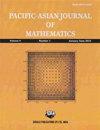内万林纳理论通过全纯形式
IF 0.7
3区 数学
Q2 MATHEMATICS
引用次数: 2
摘要
。本文从全纯形式的角度重新发展了C上亚纯函数的Nevanlinna理论。根据我们的观察,内万林纳函数可以用全纯形式表示。将这一思想应用于黎曼曲面,然后用全纯形式S扩展了内万林纳函数的定义。在新的条件下,得到了S -耗尽黎曼曲面上Nevanlinna理论的类比,这被视为经典Nevanlinna理论在C和D上的推广。本文章由计算机程序翻译,如有差异,请以英文原文为准。
Nevanlinna theory via holomorphic forms
. This paper re-develops Nevanlinna theory for meromorphic functions on C in the viewpoint of holomorphic forms. According to our observation, Nevanlinna’s functions can be formulated by a holomorphic form. Applying this thought to Riemann surfaces, one then extends the definition of Nevanlinna’s functions using a holomorphic form S . With the new settings, an analogue of Nevanlinna theory on the S -exhausted Riemann surfaces is obtained, which is viewed as a generalization of the classical Nevanlinna theory for C and D .
求助全文
通过发布文献求助,成功后即可免费获取论文全文。
去求助
来源期刊
CiteScore
1.30
自引率
0.00%
发文量
93
审稿时长
4-8 weeks
期刊介绍:
Founded in 1951, PJM has published mathematics research for more than 60 years. PJM is run by mathematicians from the Pacific Rim. PJM aims to publish high-quality articles in all branches of mathematics, at low cost to libraries and individuals. The Pacific Journal of Mathematics is incorporated as a 501(c)(3) California nonprofit.

 求助内容:
求助内容: 应助结果提醒方式:
应助结果提醒方式:


